Impact of Information Technology on Supply Chain Performance Analysis
VerifiedAdded on 2023/01/19
|19
|4413
|87
Report
AI Summary
This research report explores the impact of information technology (IT) on supply chain performance. The study delves into the significance of IT in enhancing information flow and improving organizational efficiency within the context of a competitive business environment. It examines the role of Enterprise Resource Planning (ERP) and inter-organizational information systems (IOS) in supply chain management. The report investigates the relationship between IT infrastructure capability, information management capability, and overall supply chain performance, including the use of deductive research approach and mixed methods for data collection and analysis. It further discusses the importance of knowledge management, information sharing, and IT integration in achieving a competitive advantage. The report concludes with findings on the influence of IT on supply chain operations and provides valuable insights into how businesses can leverage technology to optimize their supply chain processes and improve their performance.
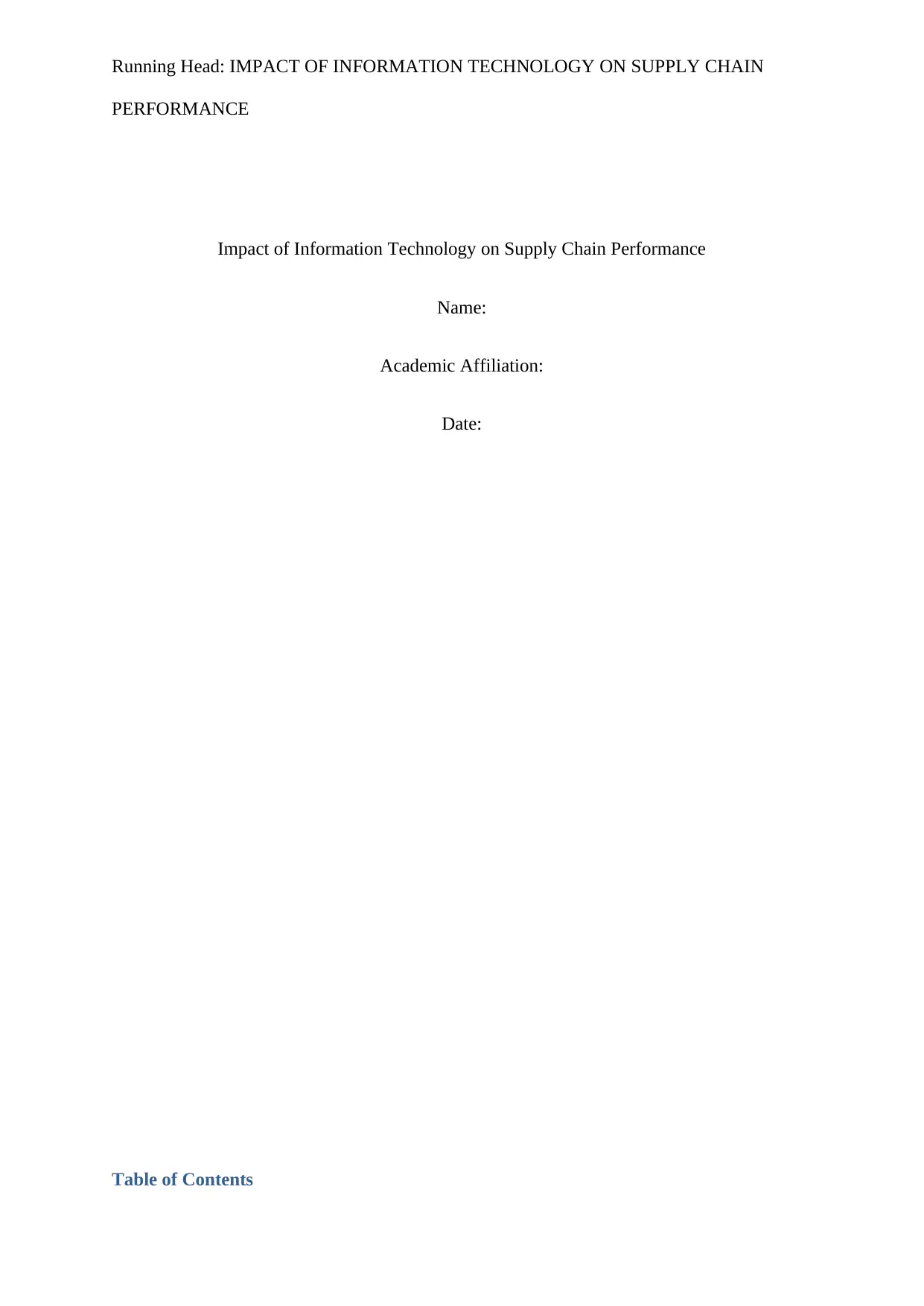
Running Head: IMPACT OF INFORMATION TECHNOLOGY ON SUPPLY CHAIN
PERFORMANCE
Impact of Information Technology on Supply Chain Performance
Name:
Academic Affiliation:
Date:
Table of Contents
PERFORMANCE
Impact of Information Technology on Supply Chain Performance
Name:
Academic Affiliation:
Date:
Table of Contents
Paraphrase This Document
Need a fresh take? Get an instant paraphrase of this document with our AI Paraphraser
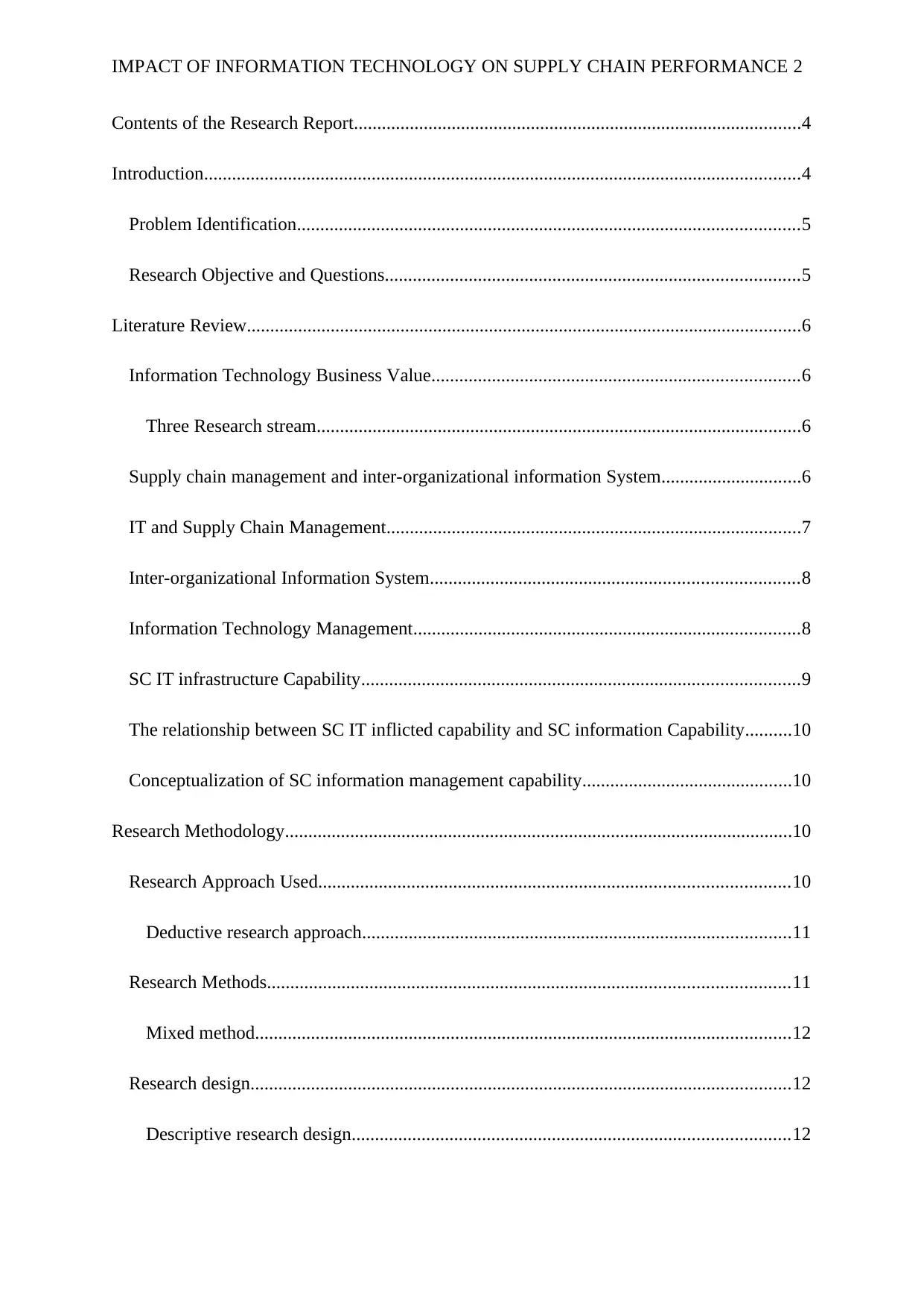
IMPACT OF INFORMATION TECHNOLOGY ON SUPPLY CHAIN PERFORMANCE 2
Contents of the Research Report................................................................................................4
Introduction................................................................................................................................4
Problem Identification............................................................................................................5
Research Objective and Questions.........................................................................................5
Literature Review.......................................................................................................................6
Information Technology Business Value...............................................................................6
Three Research stream........................................................................................................6
Supply chain management and inter-organizational information System..............................6
IT and Supply Chain Management.........................................................................................7
Inter-organizational Information System...............................................................................8
Information Technology Management...................................................................................8
SC IT infrastructure Capability..............................................................................................9
The relationship between SC IT inflicted capability and SC information Capability..........10
Conceptualization of SC information management capability.............................................10
Research Methodology.............................................................................................................10
Research Approach Used.....................................................................................................10
Deductive research approach............................................................................................11
Research Methods................................................................................................................11
Mixed method...................................................................................................................12
Research design....................................................................................................................12
Descriptive research design..............................................................................................12
Contents of the Research Report................................................................................................4
Introduction................................................................................................................................4
Problem Identification............................................................................................................5
Research Objective and Questions.........................................................................................5
Literature Review.......................................................................................................................6
Information Technology Business Value...............................................................................6
Three Research stream........................................................................................................6
Supply chain management and inter-organizational information System..............................6
IT and Supply Chain Management.........................................................................................7
Inter-organizational Information System...............................................................................8
Information Technology Management...................................................................................8
SC IT infrastructure Capability..............................................................................................9
The relationship between SC IT inflicted capability and SC information Capability..........10
Conceptualization of SC information management capability.............................................10
Research Methodology.............................................................................................................10
Research Approach Used.....................................................................................................10
Deductive research approach............................................................................................11
Research Methods................................................................................................................11
Mixed method...................................................................................................................12
Research design....................................................................................................................12
Descriptive research design..............................................................................................12
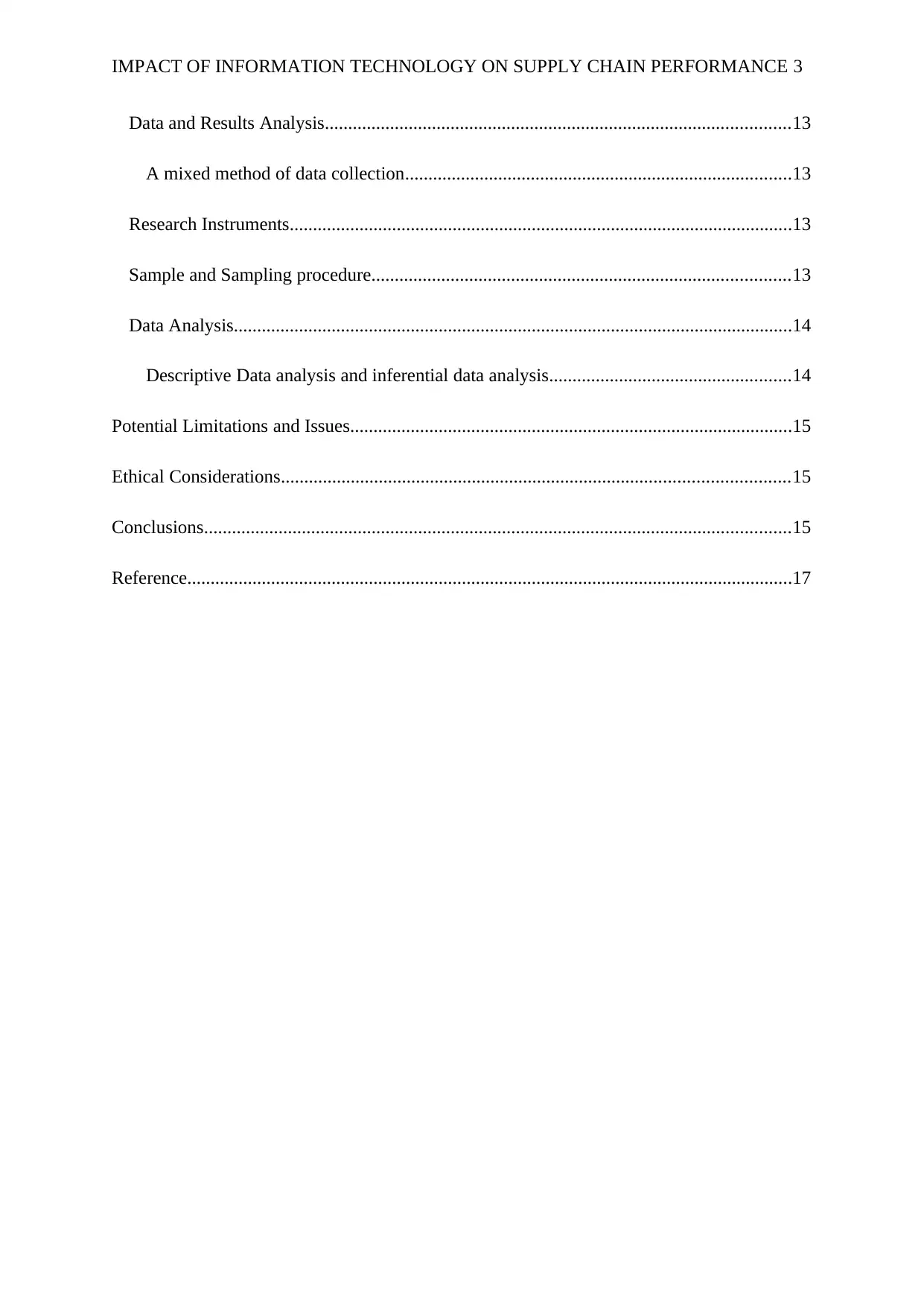
IMPACT OF INFORMATION TECHNOLOGY ON SUPPLY CHAIN PERFORMANCE 3
Data and Results Analysis....................................................................................................13
A mixed method of data collection...................................................................................13
Research Instruments............................................................................................................13
Sample and Sampling procedure..........................................................................................13
Data Analysis........................................................................................................................14
Descriptive Data analysis and inferential data analysis....................................................14
Potential Limitations and Issues...............................................................................................15
Ethical Considerations.............................................................................................................15
Conclusions..............................................................................................................................15
Reference..................................................................................................................................17
Data and Results Analysis....................................................................................................13
A mixed method of data collection...................................................................................13
Research Instruments............................................................................................................13
Sample and Sampling procedure..........................................................................................13
Data Analysis........................................................................................................................14
Descriptive Data analysis and inferential data analysis....................................................14
Potential Limitations and Issues...............................................................................................15
Ethical Considerations.............................................................................................................15
Conclusions..............................................................................................................................15
Reference..................................................................................................................................17
⊘ This is a preview!⊘
Do you want full access?
Subscribe today to unlock all pages.

Trusted by 1+ million students worldwide
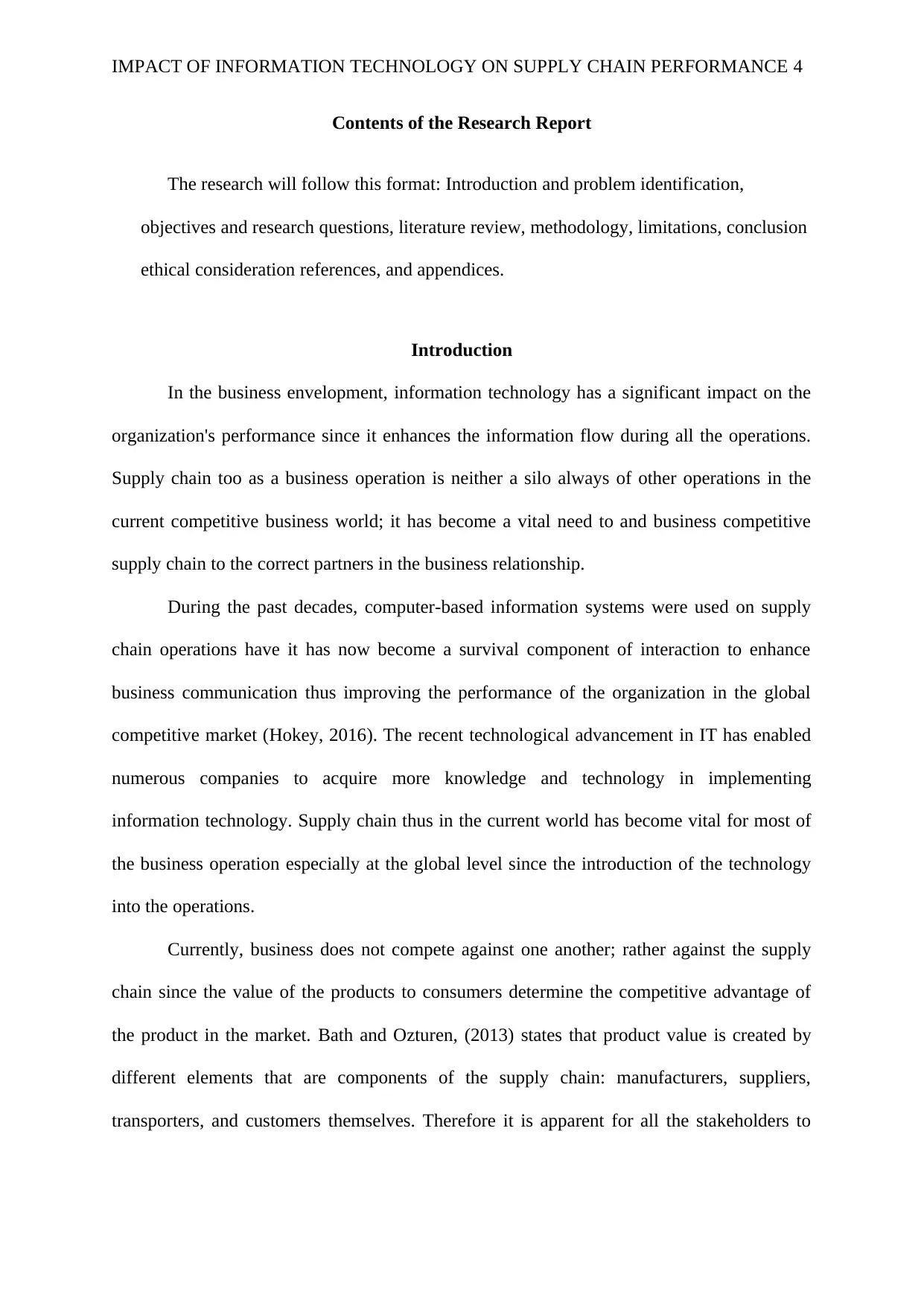
IMPACT OF INFORMATION TECHNOLOGY ON SUPPLY CHAIN PERFORMANCE 4
Contents of the Research Report
The research will follow this format: Introduction and problem identification,
objectives and research questions, literature review, methodology, limitations, conclusion
ethical consideration references, and appendices.
Introduction
In the business envelopment, information technology has a significant impact on the
organization's performance since it enhances the information flow during all the operations.
Supply chain too as a business operation is neither a silo always of other operations in the
current competitive business world; it has become a vital need to and business competitive
supply chain to the correct partners in the business relationship.
During the past decades, computer-based information systems were used on supply
chain operations have it has now become a survival component of interaction to enhance
business communication thus improving the performance of the organization in the global
competitive market (Hokey, 2016). The recent technological advancement in IT has enabled
numerous companies to acquire more knowledge and technology in implementing
information technology. Supply chain thus in the current world has become vital for most of
the business operation especially at the global level since the introduction of the technology
into the operations.
Currently, business does not compete against one another; rather against the supply
chain since the value of the products to consumers determine the competitive advantage of
the product in the market. Bath and Ozturen, (2013) states that product value is created by
different elements that are components of the supply chain: manufacturers, suppliers,
transporters, and customers themselves. Therefore it is apparent for all the stakeholders to
Contents of the Research Report
The research will follow this format: Introduction and problem identification,
objectives and research questions, literature review, methodology, limitations, conclusion
ethical consideration references, and appendices.
Introduction
In the business envelopment, information technology has a significant impact on the
organization's performance since it enhances the information flow during all the operations.
Supply chain too as a business operation is neither a silo always of other operations in the
current competitive business world; it has become a vital need to and business competitive
supply chain to the correct partners in the business relationship.
During the past decades, computer-based information systems were used on supply
chain operations have it has now become a survival component of interaction to enhance
business communication thus improving the performance of the organization in the global
competitive market (Hokey, 2016). The recent technological advancement in IT has enabled
numerous companies to acquire more knowledge and technology in implementing
information technology. Supply chain thus in the current world has become vital for most of
the business operation especially at the global level since the introduction of the technology
into the operations.
Currently, business does not compete against one another; rather against the supply
chain since the value of the products to consumers determine the competitive advantage of
the product in the market. Bath and Ozturen, (2013) states that product value is created by
different elements that are components of the supply chain: manufacturers, suppliers,
transporters, and customers themselves. Therefore it is apparent for all the stakeholders to
Paraphrase This Document
Need a fresh take? Get an instant paraphrase of this document with our AI Paraphraser
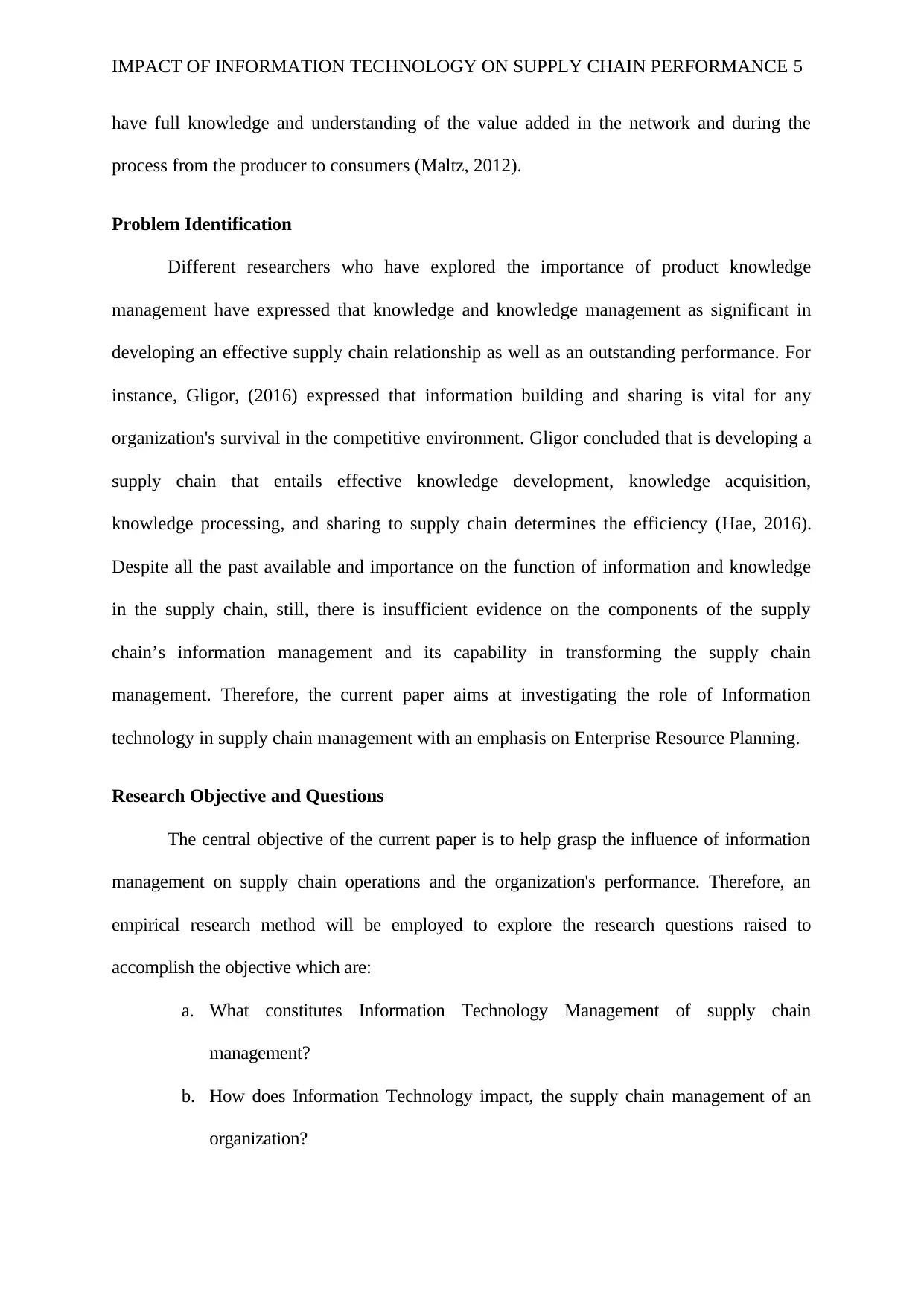
IMPACT OF INFORMATION TECHNOLOGY ON SUPPLY CHAIN PERFORMANCE 5
have full knowledge and understanding of the value added in the network and during the
process from the producer to consumers (Maltz, 2012).
Problem Identification
Different researchers who have explored the importance of product knowledge
management have expressed that knowledge and knowledge management as significant in
developing an effective supply chain relationship as well as an outstanding performance. For
instance, Gligor, (2016) expressed that information building and sharing is vital for any
organization's survival in the competitive environment. Gligor concluded that is developing a
supply chain that entails effective knowledge development, knowledge acquisition,
knowledge processing, and sharing to supply chain determines the efficiency (Hae, 2016).
Despite all the past available and importance on the function of information and knowledge
in the supply chain, still, there is insufficient evidence on the components of the supply
chain’s information management and its capability in transforming the supply chain
management. Therefore, the current paper aims at investigating the role of Information
technology in supply chain management with an emphasis on Enterprise Resource Planning.
Research Objective and Questions
The central objective of the current paper is to help grasp the influence of information
management on supply chain operations and the organization's performance. Therefore, an
empirical research method will be employed to explore the research questions raised to
accomplish the objective which are:
a. What constitutes Information Technology Management of supply chain
management?
b. How does Information Technology impact, the supply chain management of an
organization?
have full knowledge and understanding of the value added in the network and during the
process from the producer to consumers (Maltz, 2012).
Problem Identification
Different researchers who have explored the importance of product knowledge
management have expressed that knowledge and knowledge management as significant in
developing an effective supply chain relationship as well as an outstanding performance. For
instance, Gligor, (2016) expressed that information building and sharing is vital for any
organization's survival in the competitive environment. Gligor concluded that is developing a
supply chain that entails effective knowledge development, knowledge acquisition,
knowledge processing, and sharing to supply chain determines the efficiency (Hae, 2016).
Despite all the past available and importance on the function of information and knowledge
in the supply chain, still, there is insufficient evidence on the components of the supply
chain’s information management and its capability in transforming the supply chain
management. Therefore, the current paper aims at investigating the role of Information
technology in supply chain management with an emphasis on Enterprise Resource Planning.
Research Objective and Questions
The central objective of the current paper is to help grasp the influence of information
management on supply chain operations and the organization's performance. Therefore, an
empirical research method will be employed to explore the research questions raised to
accomplish the objective which are:
a. What constitutes Information Technology Management of supply chain
management?
b. How does Information Technology impact, the supply chain management of an
organization?
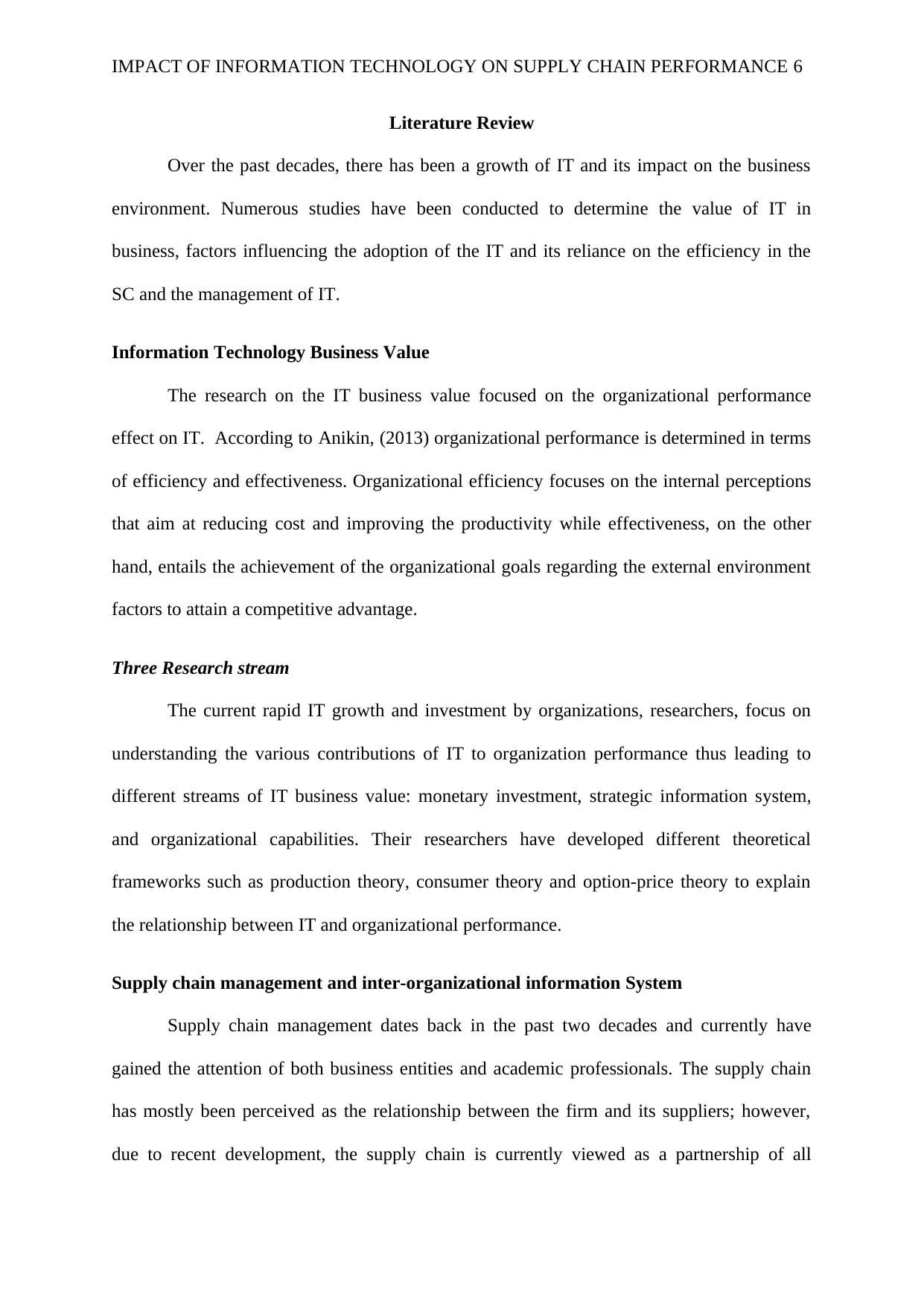
IMPACT OF INFORMATION TECHNOLOGY ON SUPPLY CHAIN PERFORMANCE 6
Literature Review
Over the past decades, there has been a growth of IT and its impact on the business
environment. Numerous studies have been conducted to determine the value of IT in
business, factors influencing the adoption of the IT and its reliance on the efficiency in the
SC and the management of IT.
Information Technology Business Value
The research on the IT business value focused on the organizational performance
effect on IT. According to Anikin, (2013) organizational performance is determined in terms
of efficiency and effectiveness. Organizational efficiency focuses on the internal perceptions
that aim at reducing cost and improving the productivity while effectiveness, on the other
hand, entails the achievement of the organizational goals regarding the external environment
factors to attain a competitive advantage.
Three Research stream
The current rapid IT growth and investment by organizations, researchers, focus on
understanding the various contributions of IT to organization performance thus leading to
different streams of IT business value: monetary investment, strategic information system,
and organizational capabilities. Their researchers have developed different theoretical
frameworks such as production theory, consumer theory and option-price theory to explain
the relationship between IT and organizational performance.
Supply chain management and inter-organizational information System
Supply chain management dates back in the past two decades and currently have
gained the attention of both business entities and academic professionals. The supply chain
has mostly been perceived as the relationship between the firm and its suppliers; however,
due to recent development, the supply chain is currently viewed as a partnership of all
Literature Review
Over the past decades, there has been a growth of IT and its impact on the business
environment. Numerous studies have been conducted to determine the value of IT in
business, factors influencing the adoption of the IT and its reliance on the efficiency in the
SC and the management of IT.
Information Technology Business Value
The research on the IT business value focused on the organizational performance
effect on IT. According to Anikin, (2013) organizational performance is determined in terms
of efficiency and effectiveness. Organizational efficiency focuses on the internal perceptions
that aim at reducing cost and improving the productivity while effectiveness, on the other
hand, entails the achievement of the organizational goals regarding the external environment
factors to attain a competitive advantage.
Three Research stream
The current rapid IT growth and investment by organizations, researchers, focus on
understanding the various contributions of IT to organization performance thus leading to
different streams of IT business value: monetary investment, strategic information system,
and organizational capabilities. Their researchers have developed different theoretical
frameworks such as production theory, consumer theory and option-price theory to explain
the relationship between IT and organizational performance.
Supply chain management and inter-organizational information System
Supply chain management dates back in the past two decades and currently have
gained the attention of both business entities and academic professionals. The supply chain
has mostly been perceived as the relationship between the firm and its suppliers; however,
due to recent development, the supply chain is currently viewed as a partnership of all
⊘ This is a preview!⊘
Do you want full access?
Subscribe today to unlock all pages.

Trusted by 1+ million students worldwide
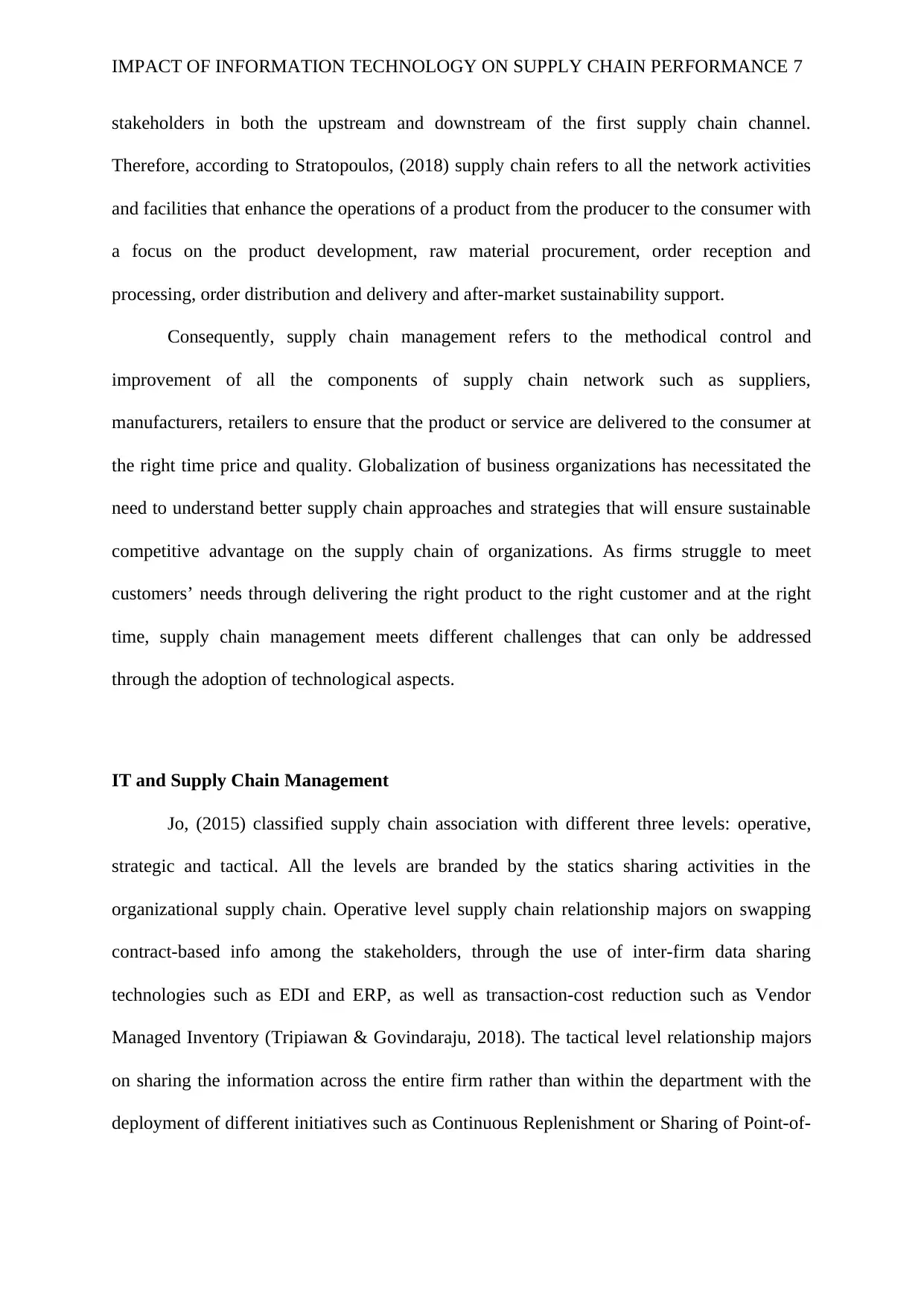
IMPACT OF INFORMATION TECHNOLOGY ON SUPPLY CHAIN PERFORMANCE 7
stakeholders in both the upstream and downstream of the first supply chain channel.
Therefore, according to Stratopoulos, (2018) supply chain refers to all the network activities
and facilities that enhance the operations of a product from the producer to the consumer with
a focus on the product development, raw material procurement, order reception and
processing, order distribution and delivery and after-market sustainability support.
Consequently, supply chain management refers to the methodical control and
improvement of all the components of supply chain network such as suppliers,
manufacturers, retailers to ensure that the product or service are delivered to the consumer at
the right time price and quality. Globalization of business organizations has necessitated the
need to understand better supply chain approaches and strategies that will ensure sustainable
competitive advantage on the supply chain of organizations. As firms struggle to meet
customers’ needs through delivering the right product to the right customer and at the right
time, supply chain management meets different challenges that can only be addressed
through the adoption of technological aspects.
IT and Supply Chain Management
Jo, (2015) classified supply chain association with different three levels: operative,
strategic and tactical. All the levels are branded by the statics sharing activities in the
organizational supply chain. Operative level supply chain relationship majors on swapping
contract-based info among the stakeholders, through the use of inter-firm data sharing
technologies such as EDI and ERP, as well as transaction-cost reduction such as Vendor
Managed Inventory (Tripiawan & Govindaraju, 2018). The tactical level relationship majors
on sharing the information across the entire firm rather than within the department with the
deployment of different initiatives such as Continuous Replenishment or Sharing of Point-of-
stakeholders in both the upstream and downstream of the first supply chain channel.
Therefore, according to Stratopoulos, (2018) supply chain refers to all the network activities
and facilities that enhance the operations of a product from the producer to the consumer with
a focus on the product development, raw material procurement, order reception and
processing, order distribution and delivery and after-market sustainability support.
Consequently, supply chain management refers to the methodical control and
improvement of all the components of supply chain network such as suppliers,
manufacturers, retailers to ensure that the product or service are delivered to the consumer at
the right time price and quality. Globalization of business organizations has necessitated the
need to understand better supply chain approaches and strategies that will ensure sustainable
competitive advantage on the supply chain of organizations. As firms struggle to meet
customers’ needs through delivering the right product to the right customer and at the right
time, supply chain management meets different challenges that can only be addressed
through the adoption of technological aspects.
IT and Supply Chain Management
Jo, (2015) classified supply chain association with different three levels: operative,
strategic and tactical. All the levels are branded by the statics sharing activities in the
organizational supply chain. Operative level supply chain relationship majors on swapping
contract-based info among the stakeholders, through the use of inter-firm data sharing
technologies such as EDI and ERP, as well as transaction-cost reduction such as Vendor
Managed Inventory (Tripiawan & Govindaraju, 2018). The tactical level relationship majors
on sharing the information across the entire firm rather than within the department with the
deployment of different initiatives such as Continuous Replenishment or Sharing of Point-of-
Paraphrase This Document
Need a fresh take? Get an instant paraphrase of this document with our AI Paraphraser
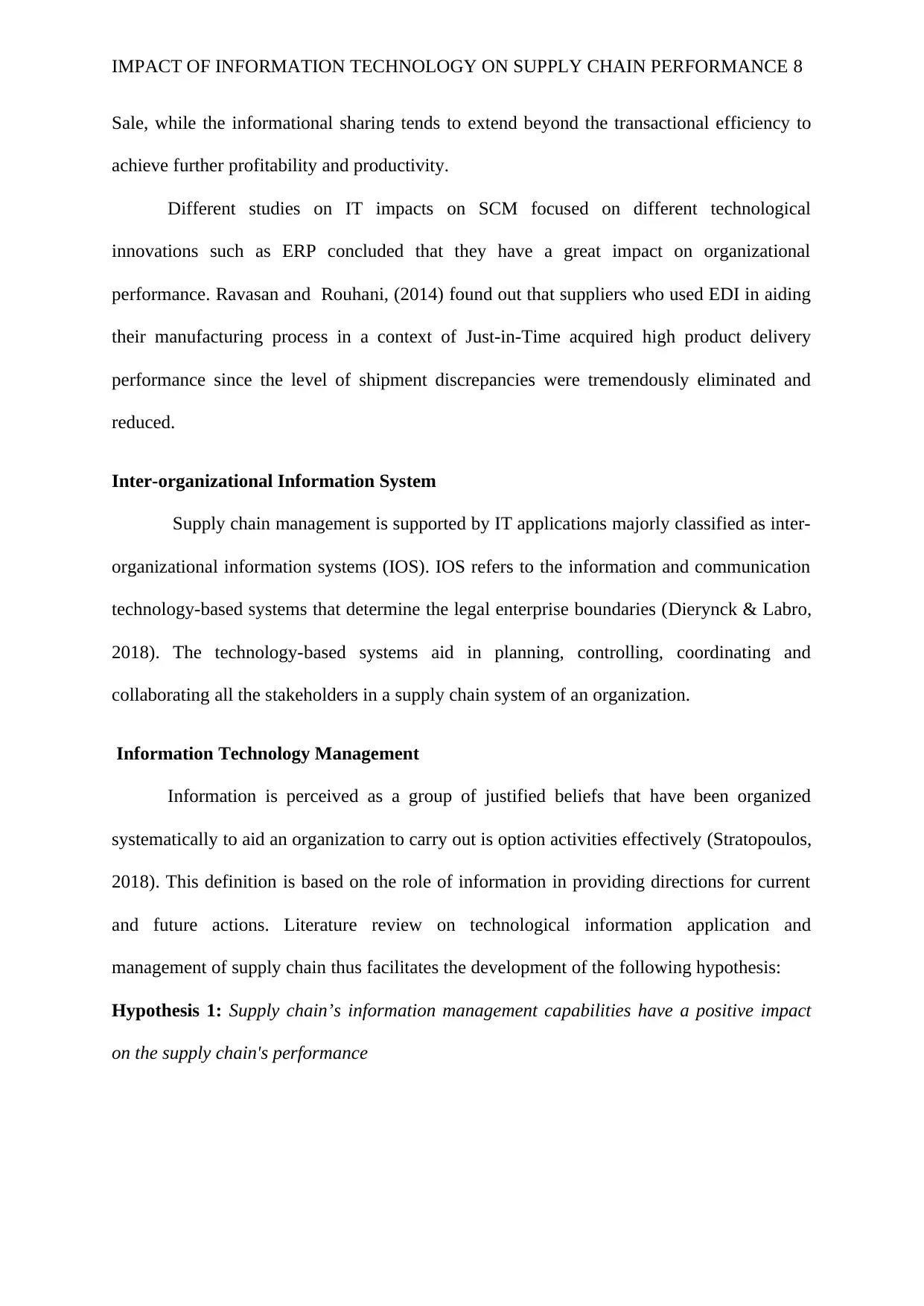
IMPACT OF INFORMATION TECHNOLOGY ON SUPPLY CHAIN PERFORMANCE 8
Sale, while the informational sharing tends to extend beyond the transactional efficiency to
achieve further profitability and productivity.
Different studies on IT impacts on SCM focused on different technological
innovations such as ERP concluded that they have a great impact on organizational
performance. Ravasan and Rouhani, (2014) found out that suppliers who used EDI in aiding
their manufacturing process in a context of Just-in-Time acquired high product delivery
performance since the level of shipment discrepancies were tremendously eliminated and
reduced.
Inter-organizational Information System
Supply chain management is supported by IT applications majorly classified as inter-
organizational information systems (IOS). IOS refers to the information and communication
technology-based systems that determine the legal enterprise boundaries (Dierynck & Labro,
2018). The technology-based systems aid in planning, controlling, coordinating and
collaborating all the stakeholders in a supply chain system of an organization.
Information Technology Management
Information is perceived as a group of justified beliefs that have been organized
systematically to aid an organization to carry out is option activities effectively (Stratopoulos,
2018). This definition is based on the role of information in providing directions for current
and future actions. Literature review on technological information application and
management of supply chain thus facilitates the development of the following hypothesis:
Hypothesis 1: Supply chain’s information management capabilities have a positive impact
on the supply chain's performance
Sale, while the informational sharing tends to extend beyond the transactional efficiency to
achieve further profitability and productivity.
Different studies on IT impacts on SCM focused on different technological
innovations such as ERP concluded that they have a great impact on organizational
performance. Ravasan and Rouhani, (2014) found out that suppliers who used EDI in aiding
their manufacturing process in a context of Just-in-Time acquired high product delivery
performance since the level of shipment discrepancies were tremendously eliminated and
reduced.
Inter-organizational Information System
Supply chain management is supported by IT applications majorly classified as inter-
organizational information systems (IOS). IOS refers to the information and communication
technology-based systems that determine the legal enterprise boundaries (Dierynck & Labro,
2018). The technology-based systems aid in planning, controlling, coordinating and
collaborating all the stakeholders in a supply chain system of an organization.
Information Technology Management
Information is perceived as a group of justified beliefs that have been organized
systematically to aid an organization to carry out is option activities effectively (Stratopoulos,
2018). This definition is based on the role of information in providing directions for current
and future actions. Literature review on technological information application and
management of supply chain thus facilitates the development of the following hypothesis:
Hypothesis 1: Supply chain’s information management capabilities have a positive impact
on the supply chain's performance
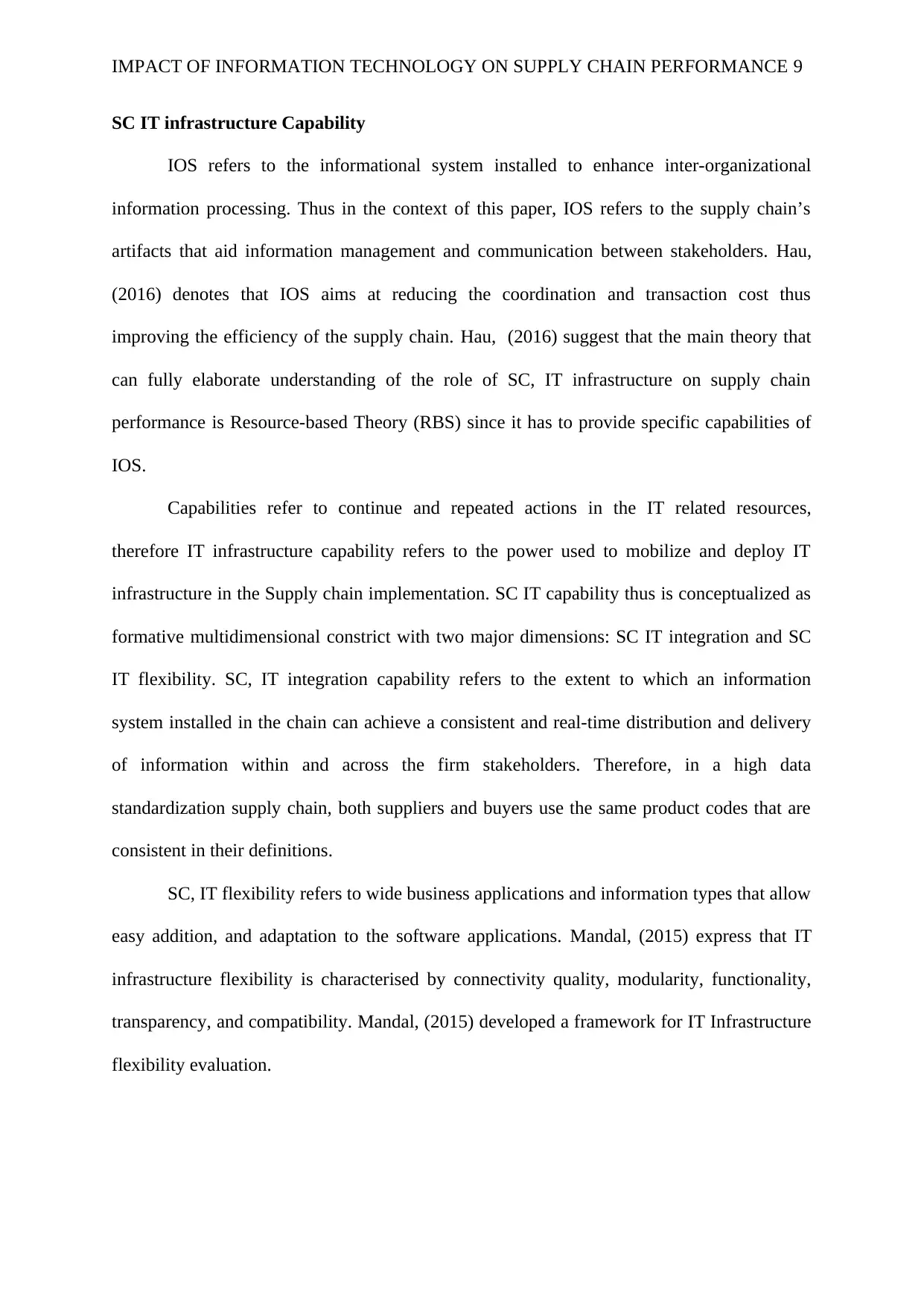
IMPACT OF INFORMATION TECHNOLOGY ON SUPPLY CHAIN PERFORMANCE 9
SC IT infrastructure Capability
IOS refers to the informational system installed to enhance inter-organizational
information processing. Thus in the context of this paper, IOS refers to the supply chain’s
artifacts that aid information management and communication between stakeholders. Hau,
(2016) denotes that IOS aims at reducing the coordination and transaction cost thus
improving the efficiency of the supply chain. Hau, (2016) suggest that the main theory that
can fully elaborate understanding of the role of SC, IT infrastructure on supply chain
performance is Resource-based Theory (RBS) since it has to provide specific capabilities of
IOS.
Capabilities refer to continue and repeated actions in the IT related resources,
therefore IT infrastructure capability refers to the power used to mobilize and deploy IT
infrastructure in the Supply chain implementation. SC IT capability thus is conceptualized as
formative multidimensional constrict with two major dimensions: SC IT integration and SC
IT flexibility. SC, IT integration capability refers to the extent to which an information
system installed in the chain can achieve a consistent and real-time distribution and delivery
of information within and across the firm stakeholders. Therefore, in a high data
standardization supply chain, both suppliers and buyers use the same product codes that are
consistent in their definitions.
SC, IT flexibility refers to wide business applications and information types that allow
easy addition, and adaptation to the software applications. Mandal, (2015) express that IT
infrastructure flexibility is characterised by connectivity quality, modularity, functionality,
transparency, and compatibility. Mandal, (2015) developed a framework for IT Infrastructure
flexibility evaluation.
SC IT infrastructure Capability
IOS refers to the informational system installed to enhance inter-organizational
information processing. Thus in the context of this paper, IOS refers to the supply chain’s
artifacts that aid information management and communication between stakeholders. Hau,
(2016) denotes that IOS aims at reducing the coordination and transaction cost thus
improving the efficiency of the supply chain. Hau, (2016) suggest that the main theory that
can fully elaborate understanding of the role of SC, IT infrastructure on supply chain
performance is Resource-based Theory (RBS) since it has to provide specific capabilities of
IOS.
Capabilities refer to continue and repeated actions in the IT related resources,
therefore IT infrastructure capability refers to the power used to mobilize and deploy IT
infrastructure in the Supply chain implementation. SC IT capability thus is conceptualized as
formative multidimensional constrict with two major dimensions: SC IT integration and SC
IT flexibility. SC, IT integration capability refers to the extent to which an information
system installed in the chain can achieve a consistent and real-time distribution and delivery
of information within and across the firm stakeholders. Therefore, in a high data
standardization supply chain, both suppliers and buyers use the same product codes that are
consistent in their definitions.
SC, IT flexibility refers to wide business applications and information types that allow
easy addition, and adaptation to the software applications. Mandal, (2015) express that IT
infrastructure flexibility is characterised by connectivity quality, modularity, functionality,
transparency, and compatibility. Mandal, (2015) developed a framework for IT Infrastructure
flexibility evaluation.
⊘ This is a preview!⊘
Do you want full access?
Subscribe today to unlock all pages.

Trusted by 1+ million students worldwide
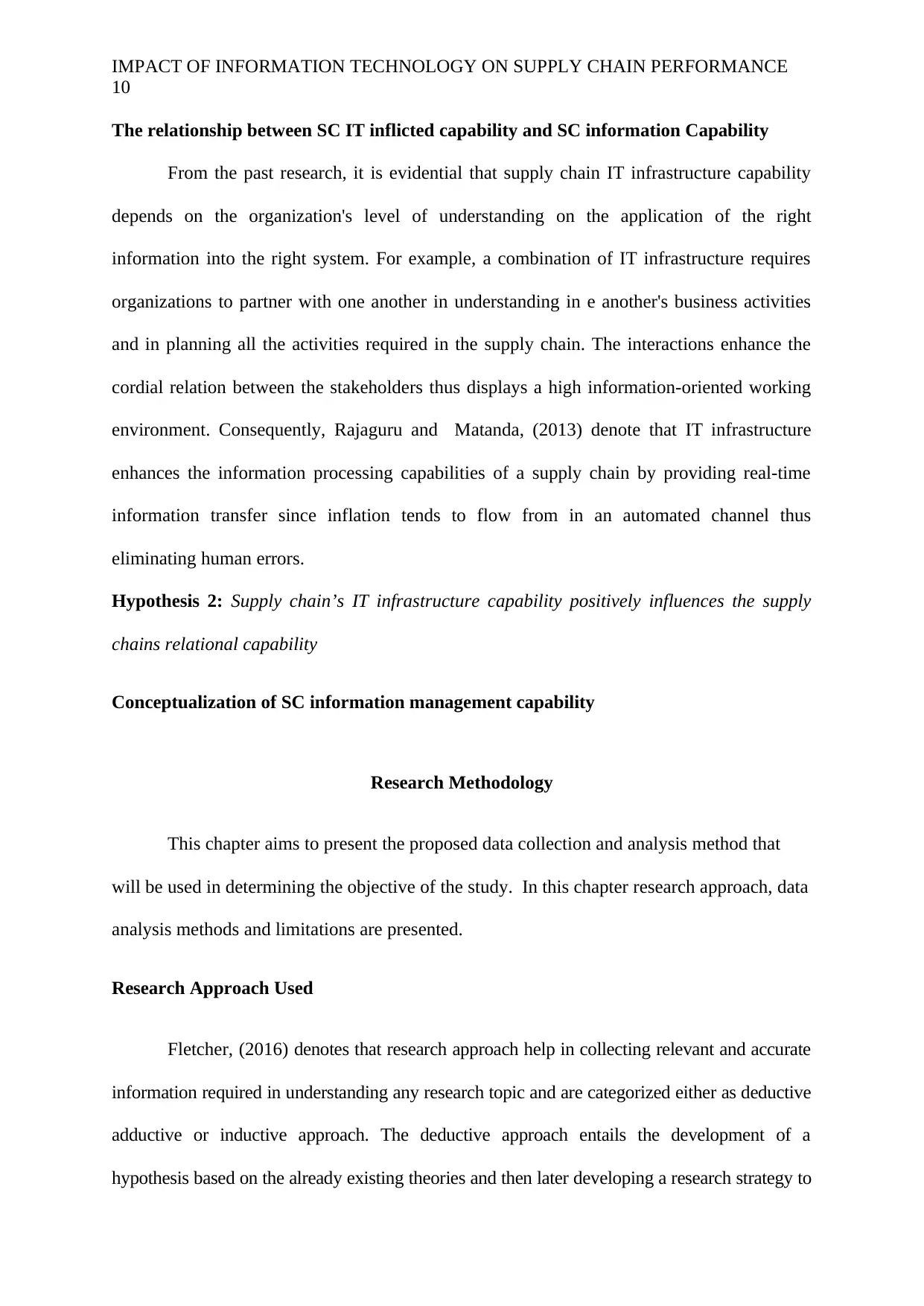
IMPACT OF INFORMATION TECHNOLOGY ON SUPPLY CHAIN PERFORMANCE
10
The relationship between SC IT inflicted capability and SC information Capability
From the past research, it is evidential that supply chain IT infrastructure capability
depends on the organization's level of understanding on the application of the right
information into the right system. For example, a combination of IT infrastructure requires
organizations to partner with one another in understanding in e another's business activities
and in planning all the activities required in the supply chain. The interactions enhance the
cordial relation between the stakeholders thus displays a high information-oriented working
environment. Consequently, Rajaguru and Matanda, (2013) denote that IT infrastructure
enhances the information processing capabilities of a supply chain by providing real-time
information transfer since inflation tends to flow from in an automated channel thus
eliminating human errors.
Hypothesis 2: Supply chain’s IT infrastructure capability positively influences the supply
chains relational capability
Conceptualization of SC information management capability
Research Methodology
This chapter aims to present the proposed data collection and analysis method that
will be used in determining the objective of the study. In this chapter research approach, data
analysis methods and limitations are presented.
Research Approach Used
Fletcher, (2016) denotes that research approach help in collecting relevant and accurate
information required in understanding any research topic and are categorized either as deductive
adductive or inductive approach. The deductive approach entails the development of a
hypothesis based on the already existing theories and then later developing a research strategy to
10
The relationship between SC IT inflicted capability and SC information Capability
From the past research, it is evidential that supply chain IT infrastructure capability
depends on the organization's level of understanding on the application of the right
information into the right system. For example, a combination of IT infrastructure requires
organizations to partner with one another in understanding in e another's business activities
and in planning all the activities required in the supply chain. The interactions enhance the
cordial relation between the stakeholders thus displays a high information-oriented working
environment. Consequently, Rajaguru and Matanda, (2013) denote that IT infrastructure
enhances the information processing capabilities of a supply chain by providing real-time
information transfer since inflation tends to flow from in an automated channel thus
eliminating human errors.
Hypothesis 2: Supply chain’s IT infrastructure capability positively influences the supply
chains relational capability
Conceptualization of SC information management capability
Research Methodology
This chapter aims to present the proposed data collection and analysis method that
will be used in determining the objective of the study. In this chapter research approach, data
analysis methods and limitations are presented.
Research Approach Used
Fletcher, (2016) denotes that research approach help in collecting relevant and accurate
information required in understanding any research topic and are categorized either as deductive
adductive or inductive approach. The deductive approach entails the development of a
hypothesis based on the already existing theories and then later developing a research strategy to
Paraphrase This Document
Need a fresh take? Get an instant paraphrase of this document with our AI Paraphraser
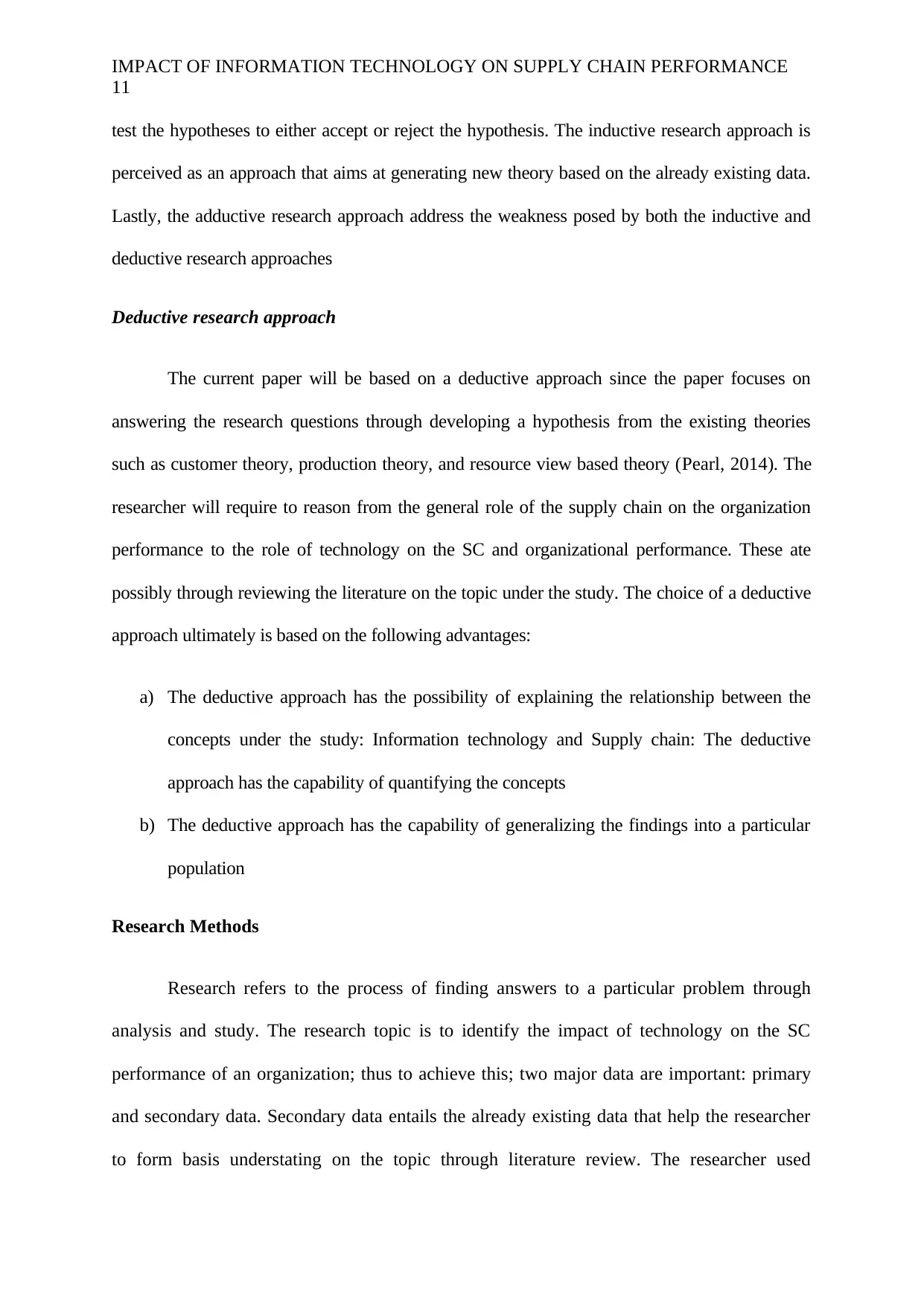
IMPACT OF INFORMATION TECHNOLOGY ON SUPPLY CHAIN PERFORMANCE
11
test the hypotheses to either accept or reject the hypothesis. The inductive research approach is
perceived as an approach that aims at generating new theory based on the already existing data.
Lastly, the adductive research approach address the weakness posed by both the inductive and
deductive research approaches
Deductive research approach
The current paper will be based on a deductive approach since the paper focuses on
answering the research questions through developing a hypothesis from the existing theories
such as customer theory, production theory, and resource view based theory (Pearl, 2014). The
researcher will require to reason from the general role of the supply chain on the organization
performance to the role of technology on the SC and organizational performance. These ate
possibly through reviewing the literature on the topic under the study. The choice of a deductive
approach ultimately is based on the following advantages:
a) The deductive approach has the possibility of explaining the relationship between the
concepts under the study: Information technology and Supply chain: The deductive
approach has the capability of quantifying the concepts
b) The deductive approach has the capability of generalizing the findings into a particular
population
Research Methods
Research refers to the process of finding answers to a particular problem through
analysis and study. The research topic is to identify the impact of technology on the SC
performance of an organization; thus to achieve this; two major data are important: primary
and secondary data. Secondary data entails the already existing data that help the researcher
to form basis understating on the topic through literature review. The researcher used
11
test the hypotheses to either accept or reject the hypothesis. The inductive research approach is
perceived as an approach that aims at generating new theory based on the already existing data.
Lastly, the adductive research approach address the weakness posed by both the inductive and
deductive research approaches
Deductive research approach
The current paper will be based on a deductive approach since the paper focuses on
answering the research questions through developing a hypothesis from the existing theories
such as customer theory, production theory, and resource view based theory (Pearl, 2014). The
researcher will require to reason from the general role of the supply chain on the organization
performance to the role of technology on the SC and organizational performance. These ate
possibly through reviewing the literature on the topic under the study. The choice of a deductive
approach ultimately is based on the following advantages:
a) The deductive approach has the possibility of explaining the relationship between the
concepts under the study: Information technology and Supply chain: The deductive
approach has the capability of quantifying the concepts
b) The deductive approach has the capability of generalizing the findings into a particular
population
Research Methods
Research refers to the process of finding answers to a particular problem through
analysis and study. The research topic is to identify the impact of technology on the SC
performance of an organization; thus to achieve this; two major data are important: primary
and secondary data. Secondary data entails the already existing data that help the researcher
to form basis understating on the topic through literature review. The researcher used
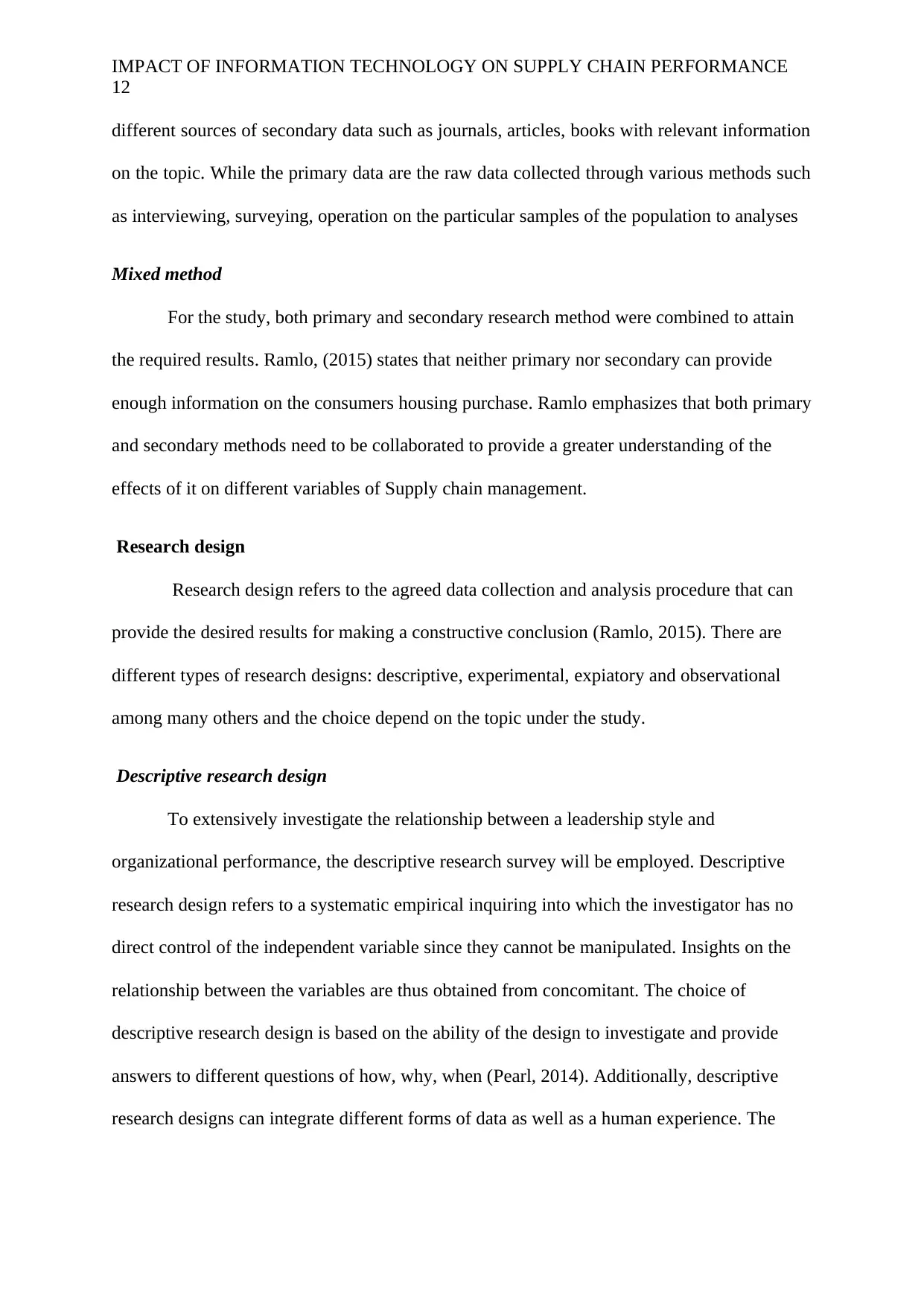
IMPACT OF INFORMATION TECHNOLOGY ON SUPPLY CHAIN PERFORMANCE
12
different sources of secondary data such as journals, articles, books with relevant information
on the topic. While the primary data are the raw data collected through various methods such
as interviewing, surveying, operation on the particular samples of the population to analyses
Mixed method
For the study, both primary and secondary research method were combined to attain
the required results. Ramlo, (2015) states that neither primary nor secondary can provide
enough information on the consumers housing purchase. Ramlo emphasizes that both primary
and secondary methods need to be collaborated to provide a greater understanding of the
effects of it on different variables of Supply chain management.
Research design
Research design refers to the agreed data collection and analysis procedure that can
provide the desired results for making a constructive conclusion (Ramlo, 2015). There are
different types of research designs: descriptive, experimental, expiatory and observational
among many others and the choice depend on the topic under the study.
Descriptive research design
To extensively investigate the relationship between a leadership style and
organizational performance, the descriptive research survey will be employed. Descriptive
research design refers to a systematic empirical inquiring into which the investigator has no
direct control of the independent variable since they cannot be manipulated. Insights on the
relationship between the variables are thus obtained from concomitant. The choice of
descriptive research design is based on the ability of the design to investigate and provide
answers to different questions of how, why, when (Pearl, 2014). Additionally, descriptive
research designs can integrate different forms of data as well as a human experience. The
12
different sources of secondary data such as journals, articles, books with relevant information
on the topic. While the primary data are the raw data collected through various methods such
as interviewing, surveying, operation on the particular samples of the population to analyses
Mixed method
For the study, both primary and secondary research method were combined to attain
the required results. Ramlo, (2015) states that neither primary nor secondary can provide
enough information on the consumers housing purchase. Ramlo emphasizes that both primary
and secondary methods need to be collaborated to provide a greater understanding of the
effects of it on different variables of Supply chain management.
Research design
Research design refers to the agreed data collection and analysis procedure that can
provide the desired results for making a constructive conclusion (Ramlo, 2015). There are
different types of research designs: descriptive, experimental, expiatory and observational
among many others and the choice depend on the topic under the study.
Descriptive research design
To extensively investigate the relationship between a leadership style and
organizational performance, the descriptive research survey will be employed. Descriptive
research design refers to a systematic empirical inquiring into which the investigator has no
direct control of the independent variable since they cannot be manipulated. Insights on the
relationship between the variables are thus obtained from concomitant. The choice of
descriptive research design is based on the ability of the design to investigate and provide
answers to different questions of how, why, when (Pearl, 2014). Additionally, descriptive
research designs can integrate different forms of data as well as a human experience. The
⊘ This is a preview!⊘
Do you want full access?
Subscribe today to unlock all pages.

Trusted by 1+ million students worldwide
1 out of 19
Related Documents
Your All-in-One AI-Powered Toolkit for Academic Success.
+13062052269
info@desklib.com
Available 24*7 on WhatsApp / Email
![[object Object]](/_next/static/media/star-bottom.7253800d.svg)
Unlock your academic potential
Copyright © 2020–2025 A2Z Services. All Rights Reserved. Developed and managed by ZUCOL.




